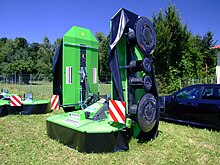Rotary mower
Rotary mowers or Kreiselmähwerke be in the agriculture used to grass (either fresh fodder , hay or silage to) mowing . They are among the rotating mowers and mow in a free cut . They are based on a development by Piet Zweegers from Geldrop in 1963 and were first brought onto the market in 1964 by his company PZ Zweegers . In order to achieve an attractive cutting result even with light cut material, circumferential blade speeds of up to 85 m / s are required. Rotary mowers are usually attached to the front and / or rear of the tractor and driven by a PTO shaft. In addition, towed or self-propelled variants are used, which allow a larger working width.
advantages
Rotary mowers are less prone to failure; the maintenance effort is low. They have a high working speed and large working widths; this achieves a high area performance (impact force).
disadvantage
Because of the rapidly rotating parts, a heavy construction is required, which requires a high level of power and capital. Protective measures against foreign objects flying around are also necessary. The forage contamination is higher compared to bar mowers . Small animals and young game usually do not have sufficient opportunity to escape due to their high impact.
Types
Drum mower
The two drums (picture) with the blade rotors are driven from above. Both rotate towards the center. This enables a decent high swath formation so that you can drive on the sward the next time you pass. That is why front mowers are often drum mowers. They work reliably even under the most difficult conditions. The usual working width is around 1.50 to 3.00 m.
Disc mower
The disc mowers are driven by a gearbox below the mower discs. This results in a lighter construction, which allows larger working widths. They are mostly used in conjunction with conditioners . Usual working widths are between 1.20 m and 4 m. Drawn variants reach 5 m.
Large mower
Large mowers are units of three individual rotary mowers that are either attached to the tractor's three-point hydraulic system or mounted on an independent carrier vehicle. They are also known as butterfly mowers. Due to its working width of up to 10 m and the simultaneous conditioning of green waste, this system is very energy-intensive and correspondingly expensive and is therefore only worthwhile with a corresponding company size, working group or contractor .
Additional equipment
Swath discs are used to move the cuttings into a narrower swath than would be the case if the drums or discs were placed. Among other things, this is desired for front mowers so that the crop is not pushed into the ground by the tractor wheels. They are plate-shaped, mounted vertically and work on the principle of the star turning device. As a rule, one pair of washers is sufficient, but there are also double versions. Swath discs are also sometimes used on balers or loading wagons to ensure that wide swaths can be picked up safely.
Swath merging : conveyor belts or screw conveyors transport the cuttings into a swath. This method is used when adequate drying is not possible due to the weather, as is usually the case with the last cut in autumn. With the swath merging, forage contamination and labor are reduced. In addition, the method is used when the good weather would cause extremely severe wilting with wide distribution.
As an interim solution, only one swath is guided to the center by a triple mower, so that the amount of grass from 2 mower working widths is brought together in one pass of the swather. A 2-rotor rake with a working width of 6 meters can pick up the grass from 2 lanes of a 9-meter butterfly mower.
Conditioners are used to crease, squeeze and spread the grass so that it dries faster. This means that, depending on the weather, one work step with the tedder can be saved. Conditioners improve the flow of material in disc mowers through their promoting effect.
Individual evidence
- ^ Matthias Metzler, Die Große Bautz-Chronik, DLG-Verlag, Frankfurt / Main, 2004, ISBN 3-7690-0620-8 , p. 210
literature
- Agriculture: Volume 3 - Agricultural engineering and construction . BLV Verlagsgesellschaft, Munich, ISBN 3-405-14349-7






